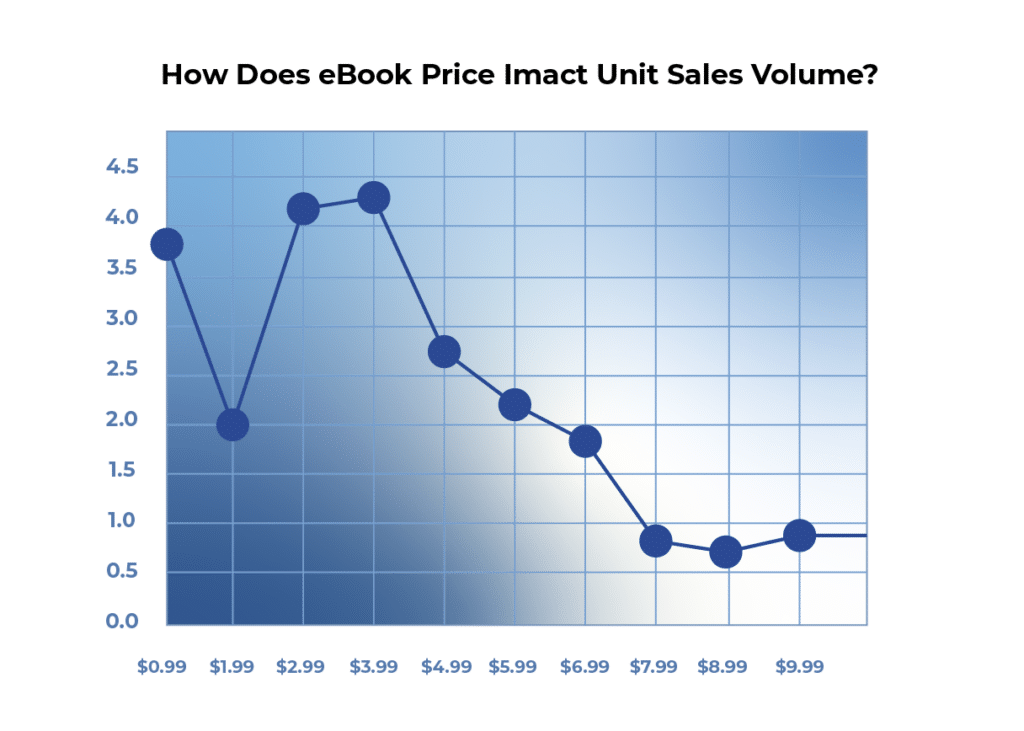Elite’s Ultimate Guide to Pricing Books and Maximizing Sales
Book pricing is an extremely nuanced process, and it always depends on the book details you give, including the royalties you intend on earning. Let’s jump right in!
eBook Pricing
The largest ebook market–by far–is Amazon, and they set the standard for ebook pricing. They have a pretty simple set of rules for how they let Authors price ebooks:
- Between $0.99 and $2.98, they pay the Author a 35% royalty
- Between $2.99 and $9.99, they pay the Author a 70% royalty
- $10 and over, they pay the Author a 35% royalty
Now, look at this chart that compares book sales to price. This data isn’t perfect, but our experience and our data watching hundreds of authors in business and personal development maps very closely to this chart.
As you can see, there are basically three tiers:
- Maximize copies: $0.99 – $3.99
- Middle ground: $4.99 – $6.99
- Maximize perceived value: $7.99 – $9.99
Some points here to note is that there is no difference in sales between $7.99 and $9.99. And perhaps most shocking, books at $0.99 sell less than books priced at $3.99.
This actually brings us to our next point, which is a very important factor for pricing business and personal development books: credibility.
Books are, within certain ranges, Veblen goods. This means that people will often judge the quality of your book, at least partially, on the price of your book.
You can even see the impact of the Veblen goods effect in the book pricing data. The fact that there is no sales difference between $7.99 and $9.99 tells you that within certain price bands, the price actually does not have an impact on demand.
The data pretty clearly show that there are four price ranges:
Why does this matter?
Because for many authors, pricing a book too low, long term, will hurt your credibility with your readers.
This is how it works with many luxury goods. People assume you are worth what you ask, so if you ask a low price, they assume that is what you are worth.
(By the way, remember that most of our Authors are not primarily focusing on making money through book sales, but rather using the book to make money in other ways.)
Given these two factors, for most authors, there are really three prices to choose from (at least for long term pricing, not counting any promotions you do):
If you want to maximize units sold: $3.99 (or possibly $0.99 in some rare cases)
If you want a good balance between sales and perception: $6.99
If you want to maximize high status perception, and don’t care about sales: $9.99
Paperback Book Pricing
At Elite, we usually use KDP for the paperback books we publish, as they are easy to use and produce high quality books.
KDP pricing is so complicated, that they actually built a calculator to help authors figure out what their royalties will be. It includes variations based on black and white versus color, length of book, bleed, and other factors.
The good news is that you don’t need to use it, because almost all of the time, the royalty rates turns out to be around 40%. For example, if you sell your paperback for $10, then you will probably get about $4 in profit.
Paperback pricing is similar to ebook pricing, just add around $7-$10 to every price.
Hardcover Book Pricing
It’s almost impossible to give broad advice on hardcover pricing and royalties, because so many factors impact the price. For example, color, printing price, size, niche, bleed, and many other factors impact the price.
Despite these variances, we’ve found a pretty solid rubric to use for hardcover book pricing that tracks pretty well with the paperback pricing: the hardcover should be $12-$15 more than the ebook.
And given this, you can expect a royalty rate of about 45%–but with HIGH variations depending on several factors.
There is an important exception to this: I would not price your hardcover above $27.99 unless you have a very specific reason.
How To Price Your Book
So let’s bring it all together, and give you the best framework for pricing:
If you want to maximize units sold:
$3.99 ebook (or $0.99 in some promotional cases) [royalty rate: 70%] $10.99-$12.99 paperback [royalty rate: ~40%] $14.99-$16.99 hardcover [royalty rate: ~45%]
If you want a good balance between sales and perception (two different options):
Option 1:
$6.99 ebook [royalty rate: 70%] $13.99-$16.99 paperback [royalty rate: ~40%] $18.99-$21.99 hardcover [royalty rate: ~45%]
Option 2 (big spread): What this does is fix your paperback and/or hardcover as your “list price,” so it stays high for perceived value. The price of an ebook is relatively low—but not too low—to maximize sales to that audience.
$4.99 eBook
$16.99 paperback
$24.99 hardcover
If you want to maximize high status perception:
$9.99 ebook [royalty rate: 70%] $17.99-$19.99 paperback [royalty rate: ~40%] $24.99-$27.99 hardcover [royalty rate: ~45%]







![[New Release] The Making of a Warrior of Light by Theresa Rubi Garcia](https://eliteonlinepublishing.com/wp-content/uploads/2025/12/Theresa-Garcia-New-Release-Elite-Blog-Post-400x250.png)
0 Comments